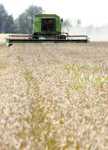Farmers beginning to see light at the end of the tunnel

SIKESTON -- Many area farmers are singing a brighter tune these days. Maybe it's something like, "I can see clearly now the rain is gone. All of my bad feelings have disappeared." Well, maybe it's not exactly like the song, but they are beginning to see light at the end of their muddy tunnel.
Farmer Tim Koch of Sikeston said he's just glad to finally be working in the fields after surviving nearly two months of continuous rain. "We had a two-day period of rain, then a four-day period of rain and another four-day period of rain, not to mention the other rains. We were flooded down here," he said.
Most Southeast Missouri farmers know exactly what Koch is talking about. Since the last few days have been pretty dry, farmers have literally worked from sun up till sun down, and as long as the rain holds off a little longer, farmers might be able to salvage what has turned into one of the worst wheat seasons ever.
"Wheat scab is very prevalent right now, especially in the northern part of the Bootheel and Cape Girardeau County," Warren Cork, agronomist for the Scott County Extension Office, said. "Each time it rains, the worse it gets."
Wheat scab, a fungal disease, associated with rain and high humidity at flowering time. It causes shrunken wheat kernels that lower yield and brings price discounts at the grain elevator.
Farmers in Southwest Missouri and in other states like Ohio and Kansas are having problems with scab. Cork said there are some areas in Missouri without any wheat scab at all.
"We had a lot of rain (in the Bootheel) during the blooming stage of wheat, and we continued to get rain after that," Cork said. "Farmers couldn't cut wheat until the rain stopped."
Koch has two back-to-back wheat fields that are connected by a tail ditch. He said one of the wheat fields was mixed with white wheat heads and Septoria, which is a leaf spot disease, while the other wasn't too bad at all.
Even though more rain is expected toward the end of the week, Koch said he should have all of all of his wheat cut by then.
Once farmers get all of their wheat cut and out of the field, the next big worry is being able to market their wheat since a lot of it is infected.
"Farmers can take the scabby wheat to the grain elevators," Cork said. "They might accept it and dock off for the bad wheat, but if the wheat is too bad, they might not accept it all."
Koch has been farming for over 30 years and he said farmers haven't had to deal with wheat scab or any other diseases in about four years. "It was so dry over the last four years, and we didn't have to worry about it," he said. "This year, because of the rain, there's a lot of crop diseases to worry about."
Recently, Koch drove through northern Scott County and admits it made him feel better about his wheat. Northern Scott County farmers had a lot more rain than southern Scott County so Koch said he thinks their wheat has seen more scab infestation.
Surprisingly, Koch said, his wheat's test weight was a lot higher than he expected. Koch's test weight was in the 50s, and a normal weight for the season is in the 60s.
The only thing left for wheat farmers to do is to get their wheat in before the next big rain, and just hope they can yield a decent crop.
Koch said he doesn't predict a high yield for his crop, but he doesn't know for sure. "I'm about halfway finished with cutting my wheat." He laughed, "So I guess I'll know after I drop it off at the elevator next week."

